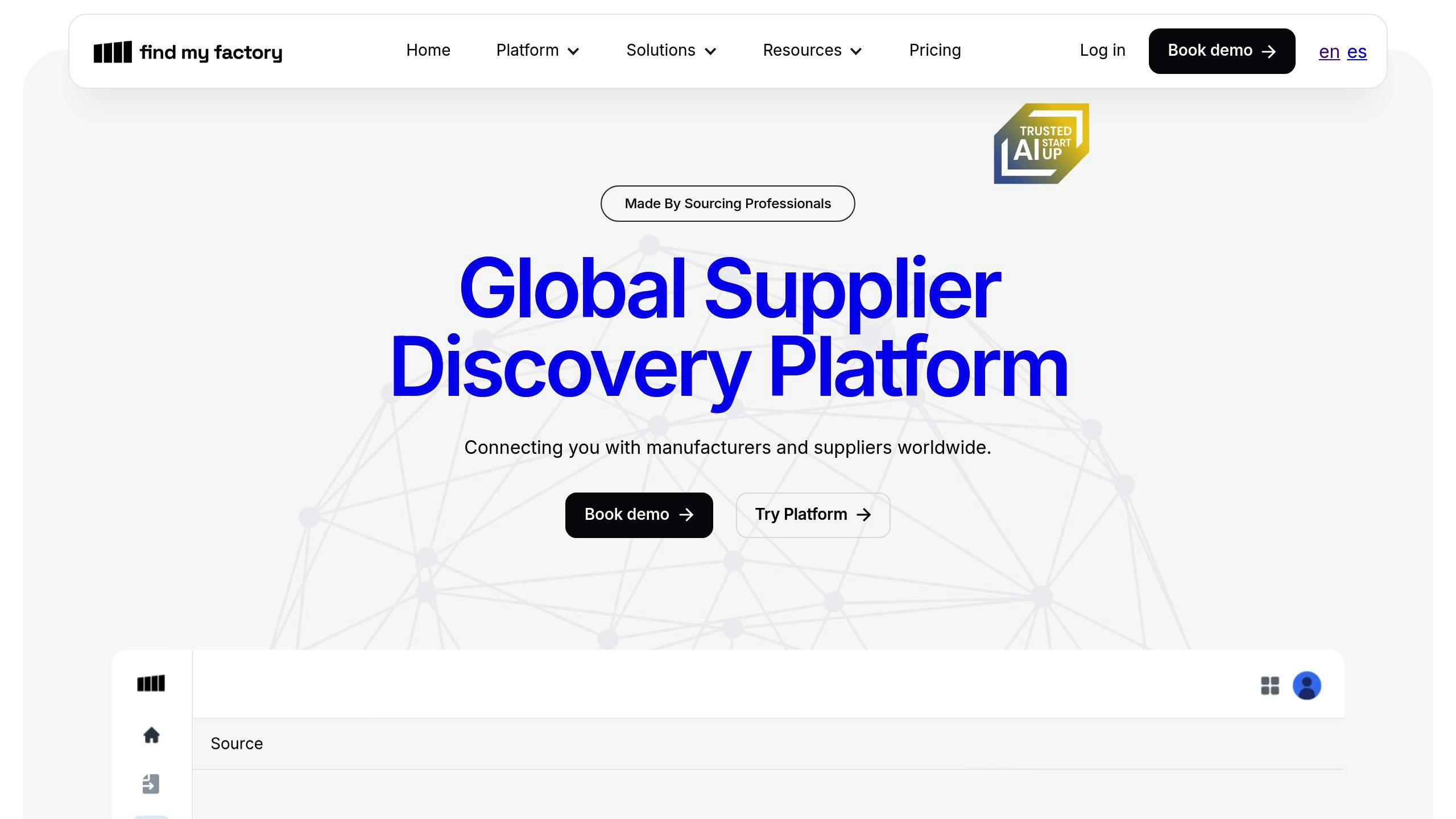Main Pages
AboutPricingSecurityCareerCustomersContactBlogFeatures
Monitor & EnrichDiscover & SourceRFI & EngageOur Socials
LinkedinLegal
Terms of UseMay 9, 2025
Explore how AI is revolutionizing supplier communication through automation, predictive analytics, and personalized interactions to enhance supply chain efficiency.
Articles

AI is transforming how businesses communicate with suppliers by automating tasks, predicting issues, and improving efficiency. Here's what you need to know:
This shift from manual processes to AI-driven tools ensures faster, more accurate, and seamless supplier communication. Let’s dive deeper into how these technologies are reshaping supply chain operations.
AI chatbots and virtual assistants are transforming how suppliers and buyers communicate. By leveraging AI's ability to predict and respond, these tools handle routine tasks efficiently and operate non-stop. They ensure faster data exchange, enhancing the responsiveness needed in competitive markets.
Chatbots equipped with natural language processing (NLP) can quickly address questions about order status, inventory, and shipments. By tapping into real-time data from enterprise systems, these tools help suppliers align their processes with buyer needs. This reduces manual work and lowers the chances of miscommunication.
Modern supply chains span time zones and languages, making seamless communication essential. AI chatbots meet this challenge by offering:
FeatureBenefit24/7 AvailabilityProvides support across all time zones with multilingual capabilities.Consistent ResponsesEnsures accurate and standardized communication in every interaction.Scalable AssistanceHandles multiple supplier inquiries at once without delays.
These automated tools not only improve day-to-day communication but also set the stage for predictive analytics to tackle potential issues before they occur.
Predictive analytics, powered by AI, takes supplier communication to the next level by shifting from reacting to problems to anticipating them. By analyzing both past data and real-time inputs, these tools help businesses address issues before they escalate. This approach ties into AI's broader role in reshaping supplier relationships, as outlined earlier.
AI uses historical supplier data to identify patterns and potential risks, ensuring early warnings about possible issues. It focuses on a few key areas:
MetricData AnalyzedSupplier PerformancePast delivery records and quality benchmarksCapacity ManagementCurrent production capabilities and workloadRisk AssessmentMarket trends and supplier stability factorsQuality ControlHistorical quality metrics and patterns of deviation
AI systems keep a constant eye on supply chain activities, sending automatic alerts when potential problems arise.
"AI can actually serve as a powerful tool to empower human collaboration and build stronger bonds with your suppliers." - RTS Labs [2]
These alerts target critical areas of supplier management, ensuring timely action:
Alert TypePurposeAction TriggerInventory AlertsAvoid stock shortages or excess inventoryMonitoring based on set thresholdsPerformance WarningsHighlight supplier performance issues earlyTriggered by declining performance metricsDelivery Risk AlertsReduce the impact of delaysReal-time notifications based on tracking dataQuality Control NotificationsEnsure consistent product qualityAlerts when quality metrics indicate problems
Machine learning is changing the way businesses communicate with suppliers by using data to create personalized strategies. These strategies take predictive analytics a step further, turning insights into actionable communication plans tailored to each supplier.
Machine learning algorithms analyze a variety of historical data points to craft communication strategies that suit each supplier. By examining interaction patterns across different channels and timeframes, businesses can refine their approach:
Data AnalyzedPurposeImpactCommunication HistoryUnderstand response times and preferred channelsBetter timing and outreach methodsPast PerformanceEvaluate quality metrics and delivery trendsFocused discussions on performanceInteraction PreferencesIdentify language and communication stylesMore effective, personalized engagementIssue ResolutionReview past problem-solving approachesSmoother and faster issue management
This process helps businesses adapt to the specific needs and behaviors of each supplier, leading to stronger and more efficient collaborations.
Turning data insights into customized interactions offers clear benefits for both businesses and suppliers. Machine learning-driven communication strategies have been shown to improve relationships and streamline operations.
Here’s how personalized communication makes a difference:
Benefit AreaImpactMeasurable OutcomeSupplier SatisfactionStrengthens relationshipsHigher supplier retention ratesCommunication EfficiencyMinimizes misunderstandingsQuicker resolution of issuesResource OptimizationAutomates routine tasksFrees up time for strategic effortsRisk ManagementFlags potential problems earlyFewer supply chain disruptions
For the best results, it's crucial to keep data accurate and update machine learning models regularly, ensuring communication strategies remain effective over time.
AI integration is reshaping how sourcing platforms handle supplier communication and collaboration. By blending real-time data processing with smart automation, these platforms are changing the way businesses interact with their suppliers.
AI-powered platforms streamline tasks like analyzing supplier data, tracking market trends, and monitoring performance metrics. This automation can cut down manual onboarding efforts by 70% [1] and allows businesses to make rapid procurement changes in unpredictable markets [3].
AI-driven platforms address many of the inefficiencies found in older, manual systems. Here's how they stack up:
FeatureTraditional PlatformsAI-Enhanced PlatformsData AnalysisManual, slow insightsAutomated, real-time updatesCommunication SpeedDelays from hours to daysInstant responses and updatesPersonalizationGeneric supplier interactionsTailored, AI-driven communicationIssue PredictionReactive problem-solvingPredictive risk managementScalabilityLimited by manual processesAutomated scaling with demandData IntegrationIsolated, siloed informationUnified, interconnected data

Find My Factory is a great example of how AI integration can elevate sourcing platforms. It combines machine learning capabilities with enterprise-level integration to offer:
These features turn outdated sourcing methods into efficient, data-driven workflows, improving supplier communication and overall collaboration.
AI has brought significant changes to supplier communication by using predictive analytics and automation to streamline processes and improve risk management.
"AI is revolutionizing supply chain operations by enabling advanced data analytics, predictive modeling, and automated decision-making" [3]
In fact, 80% of companies expect AI to have a major influence on their supply chain operations within the next two years [3]. These developments are driving several emerging trends that are shaping the future of AI-powered sourcing.
Current machine learning tools are just the beginning. Advanced models will soon deliver even more precise predictions by processing data more effectively and identifying patterns with greater accuracy. The integration of IoT devices will allow live production data to flow directly into communication systems, giving companies real-time insights and enabling quicker responses to supply chain changes.
TrendImpactAdvanced Machine Learning ModelsImproved prediction precisionIoT IntegrationReal-time visibility into supply chain operationsAutomated Decision SystemsFaster market responsePredictive AnalyticsBetter risk management
As AI tools evolve, supplier communication systems will become more connected with production planning tools. This will lead to smarter, automated communication systems capable of adjusting in real time to supply chain shifts. These advancements promise to make supplier communication faster, more efficient, and highly responsive to market dynamics.
Insights & Ideas